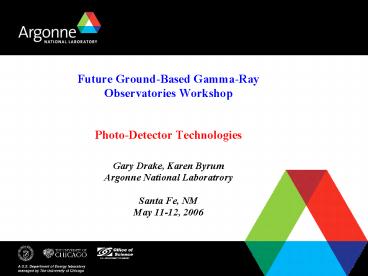Overview of PhotoDetector Properties - PowerPoint PPT Presentation
1 / 26
Title: Overview of PhotoDetector Properties
1
(No Transcript)
2
Outline of Talk
- Overview of Photo-Detector Properties
- A Quick Look At
- MAPMT
- MCPMT
- SiPM
- Photo-Cathode RD
- Conclusion
3
Overview of Photo-Detector Properties
Desirable Properties for Gamma-Ray Photo-Detectors
- Good Linearity
- Low Dark Noise
- Single pe Resolution
- Fast Signal
- High Gain
- High QE, 300-600 nm
- No After Pulsing
- Dynamic Range gt 1000
Adapted from J. Vanel, Cherenkov2005
Inexpensive would be Nice
4
Overview of Photo-Detector Properties
Plot from Talk by J. Vanel, Cherenkov2005 K.
Arisaka
5
Overview of Photo-Detector Properties
Conventional PMTs
Plot from Talk by J. Vanel, Cherenkov2005 K.
Arisaka
6
Multi-Anode PMTs
Principle of Operation
Very Similar to Conventional PMT
Photo Drawing from Talk by Tomasz
Skwarnicki, BTeV
7
Multi-Anode PMTs
Photo from Talk by Tomasz Skwarnicki, BTeV
8
Multi-Anode PMTs
9
Multi-Anode PMTs
Tests of R8900 at Argonne For Use in Trice
(ref. Byrum Talk this Workshop)
XY Stage
4-Decade Filter Wheel
10
Multi-Anode PMTs
Test Results of R8900 at Argonne (Courtesy Bob
Wagner, ANL)
11
Multi-Anode PMTs
Another Candidate 256 Channels
12
Multi-Anode PMTs
- Nice Features
- High Gain
- Good Pixel Size
- Good pe Response
- Good Linearity Dynamic Range
- Good Dark Count Rates
- Fair Packaging,
- Some Improvement of Dead Space Needed
- Not-So-Nice Features
- Pixel Non-Uniformity 21 31 Requires
Calibration, LUTs - Triggering from Dynode Incurs
- Pixel Non-uniformity Penalty
- Gains Limited to 1E5 for NSB Rates,
- Reduces Resolution of Single pe Peak
- Quantum Efficiency 20, Could Use Improvement
13
Micro-Channel Plates
Drawings from Paper by J. L. Wiza, NIM 162,
1976
14
Micro-Channel Plates
15
Micro-Channel Plates
Testing to Begin At ANL Looking at Fast Timing
16
Micro-Channel Plates
- Nice Features
- Custom-Tailor Your Pixel Size
- Good pe Response
- Good Linearity Dynamic Range
- Good Pixel Uniformity, Might Still Need
Calibration - Low Dark Count Rates
- Excellent Timing Resolution
- Not-So-Nice Features
- No Dynode for Trigger
- Current-Return Path Not Well Defined Presently
- Slow Recovery of Individual Channels, mSec
- Quantum Efficiency 20, Could Use Improvement
- Packaging Needs Improvement for Dead Space
- Operates on 2000V
17
Silicon Photo-Multipliers
Principle of Operation
Single Photodiode
SiPM
APD
- Mode of Operation Depends on
- Doping Purity of Silicon
- Bias Voltage
- Geiger Mode Needs Quenching
Adapted from Talk by Nepomuk Otte, SNIC06
18
Silicon Photo-Multipliers
Principle of Operation
Photodiode Array Sum Individual Pixels
Premise Pixels are So Small
That 1 Pixel 1 pe
Photos from Talk by V. Saveliev, 5/4/06
19
Silicon Photo-Multipliers
- SiPM Main Features
- Sensitive Size 1x1 mm2 24x24 576
pixels 32x32 1024 pixels - 2x2 mm2, 4x4 mm2 Possible
- Operating Voltage 40 to 60V
- Gain 105 up to 106
- Single Pixel Time Resolution
- 100ps
- Single Pixel Recovery Time
- 1 ?s
- No Sensitivity to Magnetic Fields
Triggered Data, 50 nS Gate
Adapted from Talk by V. Saveliev, 5/4/06
20
Silicon Photo-Multipliers
- SiPM Features
- Dark Noise Rate
- 1 MHz/mm2 _at_ Room Temp
- 1 KHz/mm2 _at_ 100K
- Optical Crosstalk
- Hot-Carrier Luminescence
- Improvements with Trenching
- Dynamic Range
- 1 pe/pixel ? Limit Pixels
Adapted from Talk by J. Vanel, Cherenkov2005
Triggered Data, 1 mS Gate (ANL Data, Bob Wagner)
ANL Teststand
Adapted from Talk by Nepomuk Otte, SNIC06
21
Silicon Photo-Multipliers
- Nice Features
- Small Size
- Low Operating Voltage
- Good pe Resolution (If Do It Right)
- Good Linearity, Fair Dynamic Range
- Good Timing Resolution
- Potential for Good QE (20 ? 40 ? 60)
- Potential for Cheap Production (Not There
Yet) - Large Arrays, Direct Integration of Electronics
Possible
? MAGIC is Considering SiPMs for New
Telescope
- Not-So-Nice Features
- Dark Current Rate is Significant
- ? Needs Cooling, or Coincidence Trigger, or High
Thresh. - Optical Crosstalk Potentially a Problem
- QE Needs Improvement
- No Dynode for Trigger
? Not Quite in Production Yet
22
Photo-Cathode RD
Slide Courtesy of J. Buckley
Higher QEgt higher cathode cost/area but smaller
telescopes with lower mechanical costs D2.5, and
smaller cathode area D2 (for a QE50, the
mechanical cost would be reduced by a factor of
gt2.4 and reduced cathode area would compensate
for higher cost/area)
23
Photo-Cathode RD
Slide Courtesy of J. Buckley
MBE AlGaN/InGaN Cathode RD Washington University
Photocathode Group Buckley, Leopold and Rebillot
24
Photo-Cathode RD
Slide Courtesy of J. Buckley
AlN-GaN-InN has a bandgap tunable between 0.8
eV (InN) and 6.2 eV (AlN) or 200 nm to gt 1000 nm
25
Photo-Cathode RD
Detected QE with HPMT in our chamber
Slide Courtesy of J. Buckley
Burle (Photonis) is currently integrating one of
our AlGaN/InGaN cathodes into a conventional PMT
- but still more device features to implement
(thicker InN and higher In concentration for
improved long wavelength response, improved
lattice matching, intinsic gain), and many
manufacturing details.
26
Conclusions
- Active Photo-Detector RD Programs in Many
Technologies - Many Innovative Ideas being Pursued
- Many Groups Active World-wide, in Development
Evaluation - Quite an Exciting Time for This Area
- ? We Can Only Profit from this Development
- Still Too Early to Tell Which Technology Will
be Best - Many Innovative Ideas being Pursued
- ? With New Approaches, Need to Choose
Technology Carefully - Personal Comments
- MAPMTs are Friendly Familiar Need Better QE,
Uniformity - MCPMTs Great for Fast Timing Need Additional
Study - SiPMs Promising Noise, Recovery, Production
Issues - APDs Good QE Need Cooling, Need Low-Noise
Elec. - HPDs Expensive, Good for B-Field, Better
Options Exist
? Elec. Dev. Closely Coupled to Det. If ASICS,
Need Time































